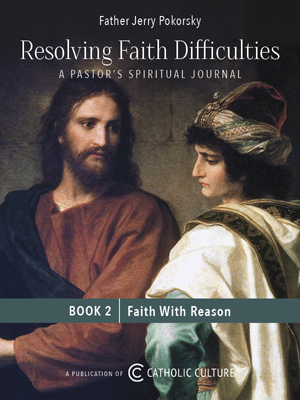Make your gift today!
Help keep Catholics around the world educated and informed.
Already donated? Log in to stop seeing these donation pop-ups.
Vatican II on the Church and the World: Man’s Calling
By Dr. Jeff Mirus ( bio - articles - email ) | Oct 15, 2010 | In On the Documents of Vatican II
The final document of the Second Vatican Council addresses the relationship of the Church to the modern world, and what the Church has to offer men as they struggle to develop and solve problems old and new. The Pastoral Constitution on the Church in the Modern World (Gaudium et Spes), promulgated on December 7, 1965, is also the Council’s longest document. However, as the Council wishes in this case to address modern problems in fairly broad terms, the document is not doctrinally dense. We can cover it in three parts.
The English title indicates that Gaudium et Spes has a pastoral purpose—the purpose of enabling the Church to speak more effectively to mankind. Therefore it should be distinguished from the earlier Dogmatic Constitution on the Church, which was devoted primarily to doctrine on the nature and constitution of the Church. By way of introduction to the current Pastoral Constitution, the Council Fathers note that the Church shares all human joys, hopes, anxieties and griefs, and so the Church wishes to propose the wisdom of Christ to the whole of redeemed humanity. “The human person deserves to be preserved; human society deserves to be renewed,” the Council notes. “Hence the focal point of our total presentation will be man himself, whole and entire, body and soul, heart and conscience, mind and will” (3).
A special “Introductory Statement” calls attention to the paradox of modern society in that “while man extends his power in every direction, he does not always succeed in subjecting it to his own welfare.” He has never had such a wealth of resources yet “a huge proportion of the world’s citizens are still tormented” by hunger, poverty and illiteracy. He has a keen interest in freedom, yet “at the same time new forms of social and psychological slavery make their appearance.” He has an intense vision of unity and solidarity, and yet the world is divided into opposing camps and conflicting forces, and “political, social, economic, racial and ideological disputes still continue bitterly.” And finally, “man painstakingly searches for a better world, without a corresponding spiritual advancement”(4).
In the midst of all this, certain specific problems arise. The modern world has moved from a “rather static concept of reality to a more dynamic, evolutionary one”, and the rate of change is very rapid (5). This has a deleterious impact on the wisdom of well-established traditions (6). The scientific worldview has enabled us to distinguish religion from magic or superstition, but as a result “growing numbers of people are abandoning religion” (7). There is a growing “imbalance between specialized human activity and a comprehensive view of reality” (8). Rapid communications have bred widespread discontent among those who “judge themselves to be deprived either through injustice or unequal distribution” of the benefits of our material culture (9). And, all in all:
Many look forward to a genuine and total emancipation of humanity wrought solely by human effort; they are convinced that the future rule of man over the earth will satisfy every desire of his heart. Nor are there lacking men who despair of any meaning to life and praise the boldness of those who think that human existence is devoid of any inherent significance and strive to confer a total meaning on it by their own ingenuity alone. (10)
But “the Church firmly believes that Christ, who died and was raised up for all, can through His Spirit offer man the light and the strength to measure up to his supreme destiny” (10). And so the Council offers this document.
The first part of Gaudium et Spes consists of four chapters covering “The Church and Man’s Calling”. The first chapter, entitled “The Dignity of the Human Person”, emphasizes that man was created in the image of God, can know and love his Creator, “and was appointed by Him as master of all earthly creatures that he might subdue them and use them to God’s glory” (12). But because man abused his liberty and finds he has “inclinations toward evil”, “therefore man is split within himself” (13). Against this promising but difficult background, the Church explains that man is a unity of body and soul and, while he “is not allowed to despise his bodily life”, nonetheless “by his interior qualities he outstrips the whole sum of mere things.” Thus he “discerns his proper destiny beneath the eyes of God” and “recognizes in himself a spiritual and immortal soul” (14). Finally, it is “through the gift of the Holy Spirit that man comes by faith to the contemplation and appreciation of the divine plan” (15).
The Fathers note that the “more right conscience holds sway, the more persons and groups turn aside from blind choice and strive to be guided by the objective norms of morality” (16). But man can pursue the good only in freedom, and so he achieves full dignity only when, “emancipating himself from all captivity to passion, be pursues his goal in a spontaneous choice of what is good, and procures for himself through effective and skillful action, apt helps to that end” (17). Moreover, though “the riddle of human existence grows most acute” in the face of death, the Church firmly teaches that “man has been created by God for a blissful purpose beyond the reach of earthly misery”, and that he “is restored to wholeness by an almighty and merciful savior” (18).
Consequently, “atheism must be accounted among the most serious problems of this age” (19). The Council goes on to review atheism in its various forms, and considers some of its causes. The Fathers sadly observe that Christians themselves contribute to the rise of atheism “to the extent that they neglect their own training in the faith, or teach erroneous doctrine, or are deficient in their religious, moral or social life” (20). Nonetheless the Church proposes that “recognition of God is in no way hostile to man’s dignity” and that the remedy for atheism is “to make God the Father and His Incarnate Son present and in a sense visible” through “the witness of a living and mature faith, namely, one trained to see difficulties clearly and to master them” (21). This is critical because, in the end, “the truth is that only in the mystery of the incarnate Word does the mystery of man take on light” (22).
In the remaining three chapters in Part I, the Council considers the nature of mankind as a community, the nature of human activity, and the role of the Church. Part II takes up the special problems of marriage and family, the development of culture, economic and social life, the political order, and the fostering of peace. I’ll cover all these sections in the next two installments.
Previous in series: Vatican II on Priests: Priestly Life
Next in series: Vatican II on the Church and the World: Community and Activity
All comments are moderated. To lighten our editing burden, only current donors are allowed to Sound Off. If you are a current donor, log in to see the comment form; otherwise please support our work, and Sound Off!








